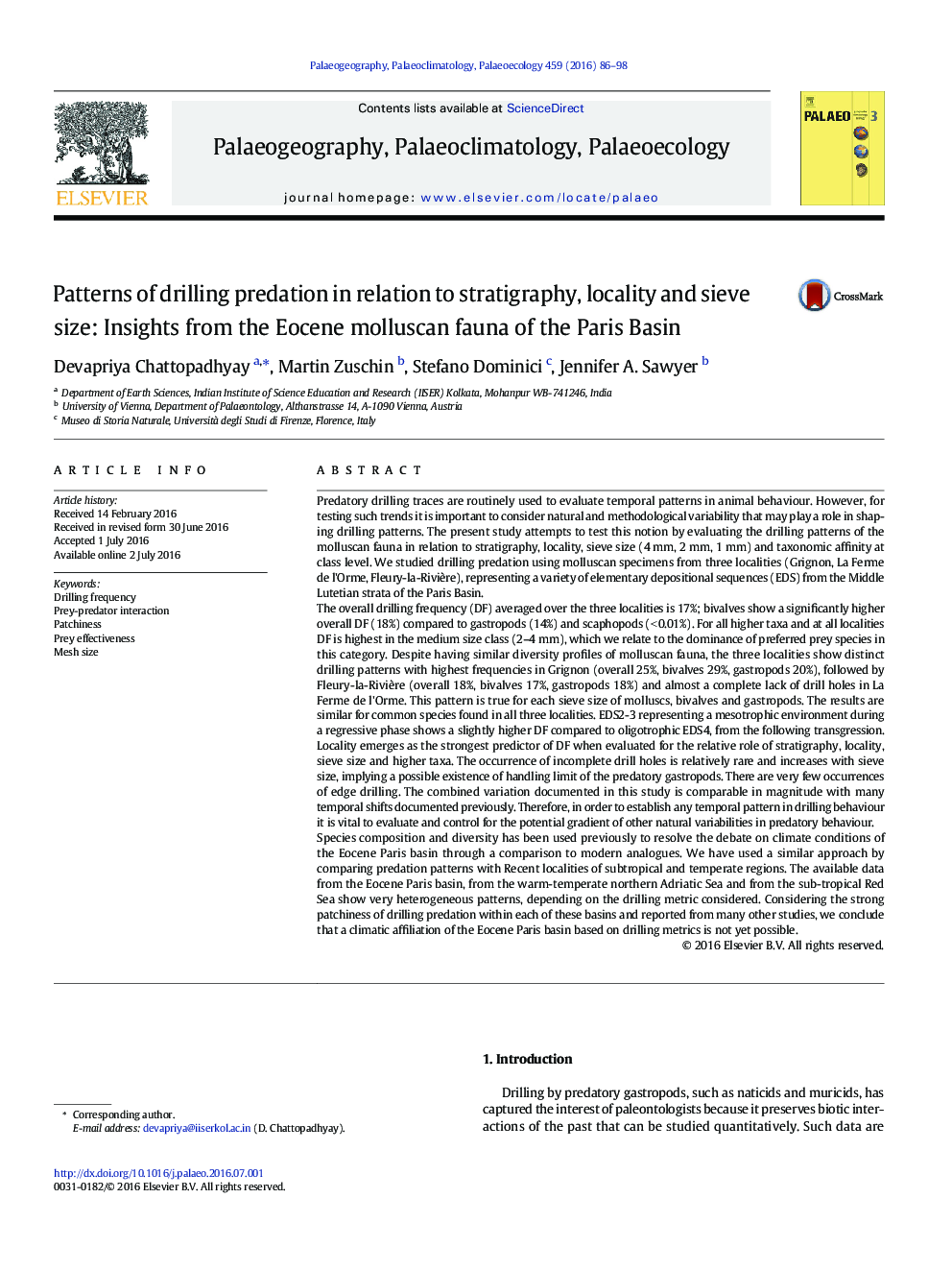| کد مقاله | کد نشریه | سال انتشار | مقاله انگلیسی | نسخه تمام متن |
|---|---|---|---|---|
| 4465625 | 1622132 | 2016 | 13 صفحه PDF | دانلود رایگان |

• A case study of drilling predation from Eocene bivalves of Paris Basin is reported.
• We tested the drilling pattern in relation to stratigraphy, locality and sieve size.
• Locality emerged as an important factor in this scenario.
• Incomplete drill holes are relatively rare and increases with sieve size.
• The variation in drilling frequency is comparable in magnitude with many temporal shifts.
Predatory drilling traces are routinely used to evaluate temporal patterns in animal behaviour. However, for testing such trends it is important to consider natural and methodological variability that may play a role in shaping drilling patterns. The present study attempts to test this notion by evaluating the drilling patterns of the molluscan fauna in relation to stratigraphy, locality, sieve size (4 mm, 2 mm, 1 mm) and taxonomic affinity at class level. We studied drilling predation using molluscan specimens from three localities (Grignon, La Ferme de l'Orme, Fleury-la-Rivière), representing a variety of elementary depositional sequences (EDS) from the Middle Lutetian strata of the Paris Basin.The overall drilling frequency (DF) averaged over the three localities is 17%; bivalves show a significantly higher overall DF (18%) compared to gastropods (14%) and scaphopods (< 0.01%). For all higher taxa and at all localities DF is highest in the medium size class (2–4 mm), which we relate to the dominance of preferred prey species in this category. Despite having similar diversity profiles of molluscan fauna, the three localities show distinct drilling patterns with highest frequencies in Grignon (overall 25%, bivalves 29%, gastropods 20%), followed by Fleury-la-Rivière (overall 18%, bivalves 17%, gastropods 18%) and almost a complete lack of drill holes in La Ferme de l'Orme. This pattern is true for each sieve size of molluscs, bivalves and gastropods. The results are similar for common species found in all three localities. EDS2-3 representing a mesotrophic environment during a regressive phase shows a slightly higher DF compared to oligotrophic EDS4, from the following transgression. Locality emerges as the strongest predictor of DF when evaluated for the relative role of stratigraphy, locality, sieve size and higher taxa. The occurrence of incomplete drill holes is relatively rare and increases with sieve size, implying a possible existence of handling limit of the predatory gastropods. There are very few occurrences of edge drilling. The combined variation documented in this study is comparable in magnitude with many temporal shifts documented previously. Therefore, in order to establish any temporal pattern in drilling behaviour it is vital to evaluate and control for the potential gradient of other natural variabilities in predatory behaviour.Species composition and diversity has been used previously to resolve the debate on climate conditions of the Eocene Paris basin through a comparison to modern analogues. We have used a similar approach by comparing predation patterns with Recent localities of subtropical and temperate regions. The available data from the Eocene Paris basin, from the warm-temperate northern Adriatic Sea and from the sub-tropical Red Sea show very heterogeneous patterns, depending on the drilling metric considered. Considering the strong patchiness of drilling predation within each of these basins and reported from many other studies, we conclude that a climatic affiliation of the Eocene Paris basin based on drilling metrics is not yet possible.
Journal: Palaeogeography, Palaeoclimatology, Palaeoecology - Volume 459, 1 October 2016, Pages 86–98